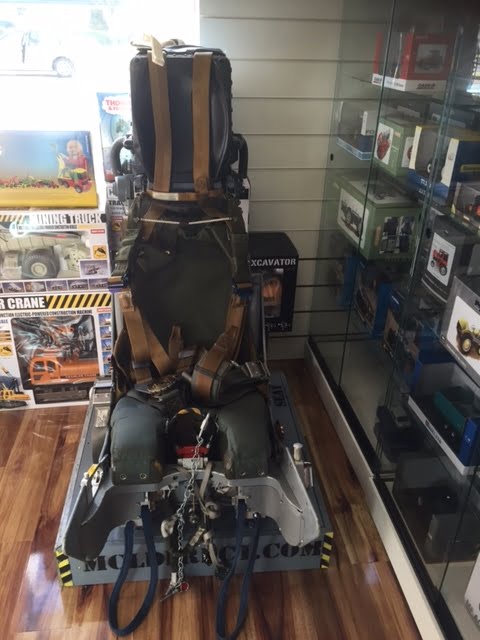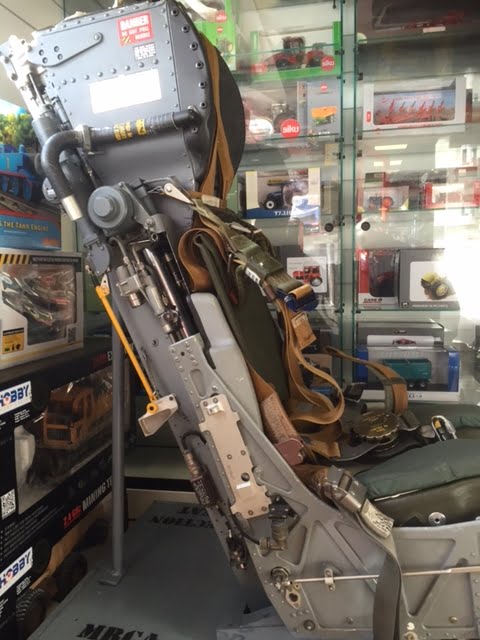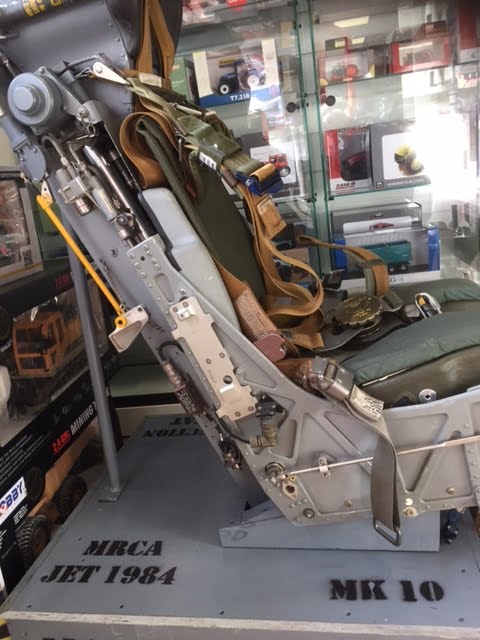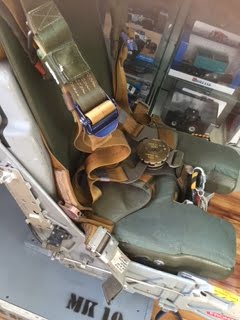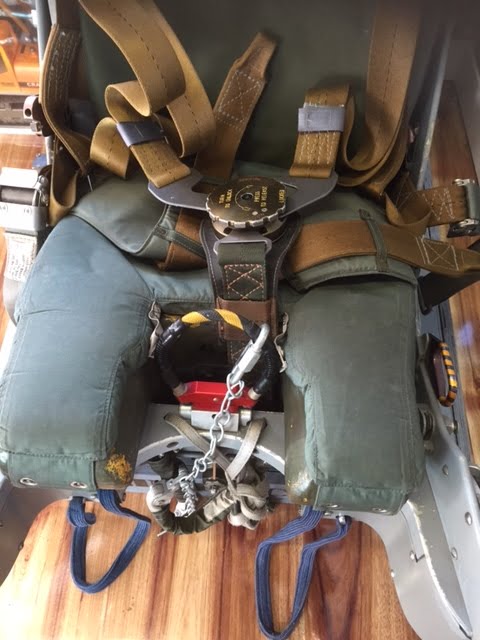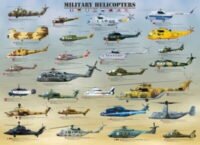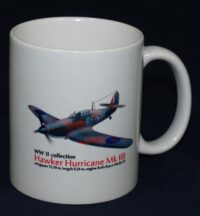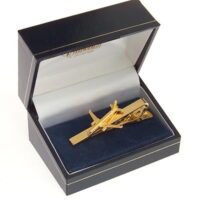Mk10A Martin Baker Ejection Seat – Display Use Only.
€4,500.00
OUT OF STOCK – EXPRESS AN INTEREST
Out of stock
- Satisfaction Guaranteed
- No Hassle Refunds
- Secure Payments
Description
MK10A Martin Baker Ejection Seat.
MCRA Tornado Jet from the RAF.
From an 1984 RAF Tornado ADV Jet Fighter. Front Pilot Seat.
Ideal for Display Purposes.
_______________________________________________________
Our Seat is mounted on a Display Stand to allow users to sit in it, strap in and to pull the Eject Handle.
On our Seat the PEC is Missing- There is no Drogue Chute inside the head Box. No Pyrotechnics or Oxygen present. No Survival gear Present.
Some Info from Martin Baker about the workings of a Live MK10 Seat.
Manufacturers Specification on a New Live Seat is below.
The Mk10 seat is designed in four main units, catapult, main beam structure, seat pan and parachute assembly. This greatly simplifies and speeds maintenance or cockpit access. The seat can be rapidly installed or removed by assembly or disassembly of the main units in the aircraft. As the aircraft canopy is not removed, valuable maintenance time is saved. The overall size footprint of the Mk10 seat has been tailored to suit a large number of aircraft installations. This design envelope flexibility enables the seat to be perfectly matched to any existing or future cockpit space limitations without adversely affecting the primary design operation of the seat. The Mk10 is currently operational in the following countries: Argentina, Australia, Bahrain, Bangladesh, Belgium, Brazil, Burkino Faso, Canada, Chile, Colombia, Congo, Czech Republic, Dominican Republic, Ecuador, Egypt, Eritea, Finland, France, Gabon, Germany, Greece, Hungary, India, Indonesia, Italy, Jordan, Kuwait, Malaysia, Mauritania, Montenegro, Myanmar, Oman, Pakistan, Peru, Philippines, Qatar, Romania, Saudi Arabia, Serbia, South Africa, South Korea, Spain, Sri Lanka, Sweden, Taiwan, Thailand, United Kingdom, USA, United Arab Emirates, Zambia and Zimbabwe.
The Mk10 seat is designed in four main units, catapult, main beam structure, seat pan and parachute assembly. This greatly simplifies and speeds maintenance or cockpit access. The seat can be rapidly installed or removed by assembly or disassembly of the main units in the aircraft. As the aircraft canopy is not removed, valuable maintenance time is saved. The overall size footprint of the Mk10 seat has been tailored to suit a large number of aircraft installations. This design envelope flexibility enables the seat to be perfectly matched to any existing or future cockpit space limitations without adversely affecting the primary design operation of the seat. The Mk10 is currently operational in the following countries: Argentina, Australia, Bahrain, Bangladesh, Belgium, Brazil, Burkino Faso, Canada, Chile, Colombia, Congo, Czech Republic, Dominican Republic, Ecuador, Egypt, Eritea, Finland, France, Gabon, Germany, Greece, Hungary, India, Indonesia, Italy, Jordan, Kuwait, Malaysia, Mauritania, Montenegro, Myanmar, Oman, Pakistan, Peru, Philippines, Qatar, Romania, Saudi Arabia, Serbia, South Africa, South Korea, Spain, Sri Lanka, Sweden, Taiwan, Thailand, United Kingdom, USA, United Arab Emirates, Zambia and Zimbabwe.
Operating Ceiling 50000+ ft (15,250m) Minimum height/Speed Zero/zero in near level attitude Crew boarding mass range 69.2 – 112.2 kg Crew size range 3rd to 99th percentile Maximum Speed for ejection 630 KIAS Parachute type GQ Type 1000 Mk 2 Parachute deployment Drogue assisted Drogue parachute type 5ft and 22 in. Drogue deployment Drogue gun. Initiated by trip rod Harness type Integrated Ejection seat operation type Ejection gun and multi-tube rocket pack Ejection gun Single, two stage Gun stroke length 72 in. Ejection initiation Handle on seat pan initiates gas operated seat firing system Electronic Sequencer No Barostatic time-release unit Yes, with 2 sec delay to give time for speed to decrease. Trip rod initiated. Automatic back-up unit No Manual override handle Yes Guillotine Yes, early variant Timers 0.50 second Drogue Gun Delay Timer, and a BTRU (barostatic time release unit) Seat adjustment Up/down Actuator operated 28 Vdc Arm restraints Yes Leg restraints Yes, two garters Oxygen supply Bottled emergency oxygen, Main oxygen system connection Personal survival pack Yes, landscale, Liferaft option available Aircrew services Personal Equipment Connector (PEC) provides connections for- main oxygen
– back-up oxygen
– emergency oxygen
– anti-g suit
– mic/tel Command ejection Yes Canopy jettison No Miniature detonating cord Yes Miniature detonating cord Yes Interseat sequencing system Yes, through command delay breech unit –
AIDC ALPHA JET AMX Casa C-101 CESSNA A-36 CHEETAH CHENGDU F-5 CHENGDU F-7 EMB-314 F-5 F-6 FOUGA 90 GRIPEN HAWK HONGDU A-5 IAI Lavi IAR-93 IAR-99 J-22 K-8 KFIR MB-339 MIRAGE PAMPA PZL L-22 S-211 SABRE SEA HARRIER SHENYANG F-5 SHENYANG F-6 SOKO SUPER TUCANO (ALX) TORNADO –
- Seat firing handle pulled causing seat initiation cartridge to fire
- Harness retraction unit operated, command firing initiated
- Primary cartridge fired causing inner and intermediate pistons to rise, releasing top latch
- Seat rises up guide rails
- Miniature detonating cord trip initiates canopy fracturing system
- Secondary cartridges fire in turn as seat rises
- Electrical connections separate disconnecting seat actuator circuit, IFF Switch and oxygen regulator supply lead
- Aircraft portion of main oxygen generating system block separate
- Disconnecting main and back-up oxygen
- Personal equipment connector aircraft portion disconnects from seat portion
- Anti-g suit hose disconnects
- Leg restraint lines draw back and restrain aircrew’s legs
- Leg restraint lines become taut and rivets shear, freeing lines from floor brackets
- Trip rods withdraw sears from drogue gun and barostatic time-release units
- Emergency oxygen trips
- Remote rocket initiator operated by static line, cartridge fires to ignite rocket pack
- Rocket pack sustains upward thrust of ejection gun, diverging trajectories for front and rear seats
- After delay mechanism has operated, drogue gun piston fires
- Ejected piston withdraws closure pin from closure flaps of drogue parachute pack and deploys drogues.
- Deployment of drogues stabilize and retard the seat and aircrew
- Low altitude/High speed
- Seat descends stabilised by drogues
- Barostatic time-release unit completes run and fire
- High speed/high altitude
- Barostatic capsule operates to prevent parachute deployment above pre-determined altitude
- Barostatic controlled g-switch delays parachute deployment above 7000ft until speed and g-force are reduced
- Barostatic time release unit operates below pre-determined altitude, completes run and fires
- Manual separation (override) used if automatic system fails
- Gas from cartridge used to
- Free drogue shackle link
- Release parachute mechanical lock
- Operate upper harness locks and lower harness release mechanism to free lower harness lugs, negative-g straps, leg restraint lines and personal equipment connector man portion
- Drogues withdraw parachute from container
- Sticker straps momentarily hold aircrew in seat
- Parachute develops, lifts aircrew and survival pack from seat and pulls sticker clips from clips causing aircrew and seat to diverge
- Normal parachute descent follows
- Aircrew releases either of two quick-release connectors to lower survival pack to end of line – Survival pack opened manually when necessary
On our Seat the PEC is Missing- There is no Drogue Chute inside the head Box. No Pyrotechnics or Oxygen present. No Survival gear Present.
Additional information
| Weight | 999 kg |
|---|

